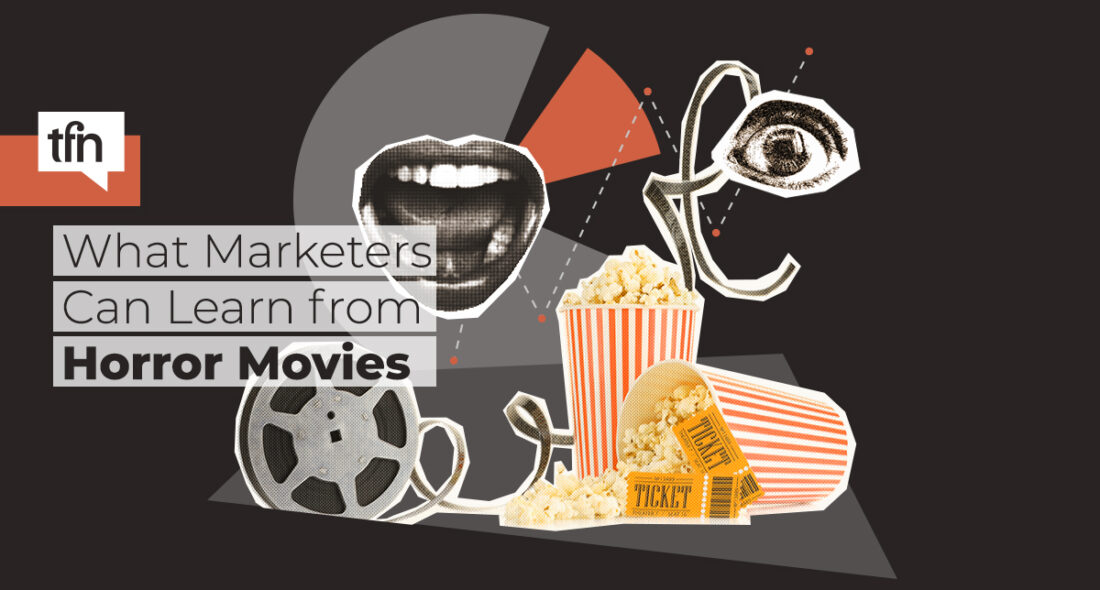
The HORROR! (or What We Can Learn From Horror Movies)
The start of the year is defined by newness: a new year, new resolutions and goals, and new horror movies. This year alone has already brought us Nosferatu, Wolf Man, and the Damned.
And whether you’re sprinting to the theatres because you love the horror genre, or avoid them altogether, it’s impossible to deny that horror movies have mastered the art of capturing attention. And marketers should take note – the strategies that make horror films so gripping can be just as effective in selling detergent, natural gas, or chicken sandwiches.
Reel Them In Like Jaws
Almost invariably, horror movies begin with a hook – a scene or moment so compelling it pulls the audience in immediately. Think of a classic like Jaws, opening with that iconic “duh-nuh”, ensuring viewers are on edge. These days, as attention spans continue to shrink, grabbing attention quickly is more important than ever to break through lightning-fast scrolling speeds. Brands have to lead with the hook: you just can’t bury the good stuff. Instead, start with your most engaging idea to make scanning eyes (or scrolling fingers) stop for a split second, locking the viewer in with a bold visual, a shocking statistic, or an intriguing question.
Emotion = ImpactEmotion can be a heck of a hook – it connects in a second, but can leave a long-lasting impression. Horror movies use fear to make viewers feel vulnerable and, consequently, alive. Of course, fear in marketing is an old, sometimes trite, and overplayed tactic. But emotionis a powerful force (and there are plenty to choose from besides fear). Hope, sympathy, nostalgia, joy, desire, aspiration, camaraderie, excitement, anticipation–all are powerful ingredients to an impactful message. Think of Publix’s heartfelt holiday spots. Or Nike’s “Find Your Greatness” campaign that highlights everyday athletes to deliver an inspiring, empowering, and challenging message. These are emotionally connective spots, and they aren’t just just memorable, they forge a deep connection between your brand and your audience.
Tease, Don’t TellSuspense is what turns jump-scare videos into long-form content. Ominous soundtracks, foreshadowing, and shadowy figures hinting at what’s to come keep audiences glued to their seats. The Blair Witch Project hinged on the fear of the unseen and unknown to keep audiences engaged long after they left the theatre (is there a witch in the Maryland woods?)…and they never even show you the witch! For marketers, building suspense in the form of teasers and breadcrumbs – mysterious social media posts or partial visuals – can build anticipation for a product launch. A little mystery can go a long way in driving engagement and curiosity.
Creativity Trumps CashUnlike most of Hollywood, the horror genre embraces relatively small budgets (in comparison to a Marvel blockbuster, for example). Paranormal Activity was made on a shoestring budget but became a cultural phenomenon because of its clever storytelling and relatable scares. It promoted the movie by showing people in the theatre watching the movie – not exactly big-budget marketing! Blendtec’s “Will It Blend?” campaign was more or less an idea, a guy, and a camera…and their YouTube channel has over 840K subscribers. Don’t let limited budgets stifle creativity. Focus on crafting a compelling story or message – mystery and suspense can come cheap.
Embrace the Uncomfortable
Horror has endured as a genre because it dares to make people uncomfortable, forcing them to feel emotions and feelings people actively avoid. Marketing often shies away from discomfort in an attempt to appeal to everyone. But that’s where the magic happens, capturing attention by creating emotion and building suspense, regardless of budget.
So learn from the masters, and build a little mystery into your storytelling–odds are it’ll produce some scary-good results.



No Comments